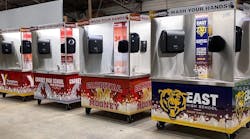Last year, something curious happened to Hitch-Hiker Manufacturing, a 52-year-old manufacturer of custom-made concession trailers. They became, in many ways, a startup.
“When COVID hit, four projects were shelved and there were no new orders coming in,” recalls Holly Swartz, who co-owns the Ohio-based family business with her husband, Jeff. “We were questioning how to keep our employees on, how to keep our industry together, and how to keep people safe.”
Six months into the pandemic, the lightbulb went off. Holly watched Ohio Gov. Mike DeWine’s press conferences every afternoon, and he always ended with a plea to stay six feet apart and wash your hands.
“We put sinks in our concession trailers all the time,” she remembers thinking one day. “So, I wondered if we could create something that allowed for hand-washing and social distancing at the same time.” This gave Jeff the spark he needed to quickly sketch a solution that drew on his decades of manufacturing and engineering experience.
That’s how the Quad Sink, a handwashing station with protective barriers for up to four people, was born. Although they originally conceived the sinks for the amusement industry, the Swartzes quickly found their real audience was schools. Pivoting their production line, finding funding, procuring patents, targeting an entirely new audience and learning to navigate the world of government procurement—suddenly these seasoned manufacturers felt like they were at the helm of a startup. It was such a pivot that they even launched a brand-new company called Personal Protected.
This is a success story. But the reality is, innovation is not easy. In MAGNET’s most recent survey of manufacturers, 75% of companies told us that innovation is not a top priority. And only one startup is commercialized in Northeast Ohio for every 10 patents—three times below the average in peer cities.
If we want to build back domestic manufacturing in the United States, especially amid supply chain bottlenecks and labor shortages, manufacturers need to reframe how they think about risk when it comes to innovation. Automatically putting all risk in the “bad” category is holding us back.
MAGNET’s Blueprint for Manufacturing in Northeast Ohio suggests a different approach. Instead of avoiding risk, companies should manage it, embrace it, and allow innovation to thrive. Here are three practical ways to do that.
1. Foster Intrapreneurship
Encouraging people to think and act like entrepreneurs inside an established company is a proven way to nurture innovation. It’s like being an entrepreneur with training wheels. It rewards risk-taking but also buffers it with the support of an experienced team. Fostering intrapreneurship starts with a culture of continuous improvement and an openness to new ideas. That’s what happened one day when an unusual call came through the switchboard at Bettcher Industries, a company that makes food-processing equipment.
“It was a tissue banking professional who asked the question, ‘Do you sell products that could be used for recovering human skin?’ I guess you can imagine the shock and surprise of someone on the customer service line. And the part of the story that I really love is rather than saying, ‘No, we don’t do that. You’ve got the wrong number,’ that spirit of ingenuity and innovation was, ‘Let me connect you with our engineers. They might have an idea on how to help you,’” says Sara Ann MacKinlay, president of Exsurco Medical.
Bettcher Industries incubated the idea—taking a proven technology from their core business and applying it in a completely novel way. The result was a revolutionary medical device that helps tissue banks recover more donated skin to help burn and trauma victims. Eventually Bettcher spun-off a whole new business called Exsurco Medical. The product that started with that unusual phone call has now captured 85% of the tissue bank market in North America.
2. Innovate the Way You Work
Kinetico is an Ohio manufacturer that’s used innovation to become a global leader in water treatment technology. On the outside, the filters look like black boxes. But inside they’re like a Swiss watch with dozens of tiny, brilliantly engineered parts that work together solely on water-power—no electricity required.
When an already COVID-constrained supply chain was further broken by a cold snap in Texas this year, Kinetico found itself in dire need of critical parts. Luckily these were not certified components involved in the actual water treatment – these can’t be changed. But they were parts essential to the integrated system that makes Kinetico filters so special. In short order, the product engineering team at Kinetico found a solution.
The team, working closely with a longtime supplier, “identified a completely new type and source of materials, rapidly prototyped its implications for our current design, and tested and validated its performance before we put it into production,” says Toby Thomas, president and CEO of Kinetico. “Our ability to come together, and innovate across the full value chain, from raw material to finished product, ensured we had no disruption to our operations,”
This example reminds us that innovation isn’t always big ideas. Sometimes getting creative about the way you work can deliver big impact. By innovating its supply chain in real time, Kinetico was able to avoid the production interruptions that crippled so many other manufacturers.
3. Build an Innovation Ecosystem
Hitch-Hiker Manufacturing, Bettcher Industries, and Kinetico are all lighthouses—illuminating the power and potential of taking smart risks. But if want more manufacturers to follow in their footsteps, we have to offer more support—particularly for small and mid-size manufacturers. This means we need to create an environment where innovation and innovators can thrive—an innovation ecosystem. We need to invest in all the supports that make spinoffs and startups easier and create common spaces for experimentation and innovation.
Here are three ideas. One, we need more funding to help established manufacturers innovate and boost physical product startups. For example, loan-loss guarantee programs—like those offered by JobsOhio to help companies invest in innovative technology. Companies only have to pay back the loan if the innovation works and the risk pays off.
Two, we need new collaborations with colleges and universities that grow engineering talent while stoking applied research and catalyzing innovation. Lorain County Community College, for example, partnered with the community to create the Great Lakes Innovation & Development Enterprise, which provides support services and funding to technology-oriented startups.
Three, contract manufacturers—a large and critical part of the industry—need extra support to embrace innovation. These companies don’t own proprietary products—they build parts to specifications provided by other manufacturers. This leaves them at the mercy of other company’s fortunes and razor-thin margins. To survive, contract manufacturers must transform from order-takers to innovators. This means finding ways to use technology to prototype faster, optimize quality and even propose innovations and enhancements to the parts they build for other companies. To help with this, organizations including MAGNET, a Manufacturing Extension Partnership (MEP), offer services that allow small manufacturers to "try-before-before-they-buy" new technologies.
Connecting all these dots and collaborating to create a powerful innovation ecosystem will ensure that manufacturers have the support they need to reinvent themselves and the region.
Reframing Risk
Foster intrapreneurship, innovate the way you work, build an ecosystem to support manufacturing innovation—and above all else, reframe the way you think about risk. Risk may have a bad reputation, but taking smart risks on innovation is what it takes to lead the world in smart manufacturing.
Ethan Karp is president and CEO of the Manufacturing Advocacy and Growth Network (MAGNET). J. Scott Cade is managing director of Cade Consulting Partners.




